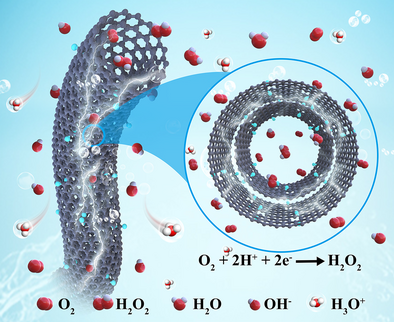Tuning Local Proton Concentration and *OOH Intermediate Generation for Efficient Acidic H2O2 Electrosynthesis at Ampere-Level Current Density
Graphical Abstract
Efficient acidic H2O2 electrosynthesis was achieved on F-CNTs with Faradaic efficiency of 95.6% at 1.0 A cm−2. F-doping regulated the electronic structure, enhanced nanoconfinement effect and oxygen mass transfer of CNTs, leading to a local alkaline microenvironment and promoted *OOH generation for acidic H2O2 electrosynthesis.
Abstract
Electrocatalytic oxygen reduction is a sustainable method for on-site H2O2 synthesis. The H2O2 in acidic media has wide downstream applications, but acidic H2O2 electrosynthesis suffers from poor efficiency due to high proton concentration and unfavourable *OOH (key intermediate) generation. Herein, acidic H2O2 electrosynthesis was enhanced by regulating local proton availability and *OOH generation via fluorine-doped on inner and outer walls of carbon nanotubes (F-CNTs). It was efficient and stable for H2O2 electrosynthesis with Faradaic efficiency of 95.6% and H2O2 yield of 606.6 mg cm−2 h−1 at 1.0 A cm−2 and 0.05 M H2SO4, outperforming the state-of-the-art electrocatalysts. The F-doping regulated the electronic structure of CNTs with elevated p-band center, and F-doping on its inner and outer walls also enhanced nanoconfinement effect and superhydrophobicity, respectively. As a result, a local alkaline microenvironment was created on F-CNTs surface during acidic H2O2 electrosynthesis. The energy barrier for *OOH generation was significantly reduced and oxygen mass transfer was boosted. Their synergistic effects promoted acidic H2O2 electrosynthesis. This work provides new insights into the mechanism for regulating H2O2 electrosynthesis.
Conflict of Interests
The authors declare no conflict of interest.
Open Research
Data Availability Statement
The data that support the findings of this study are available from the corresponding author upon reasonable request.





